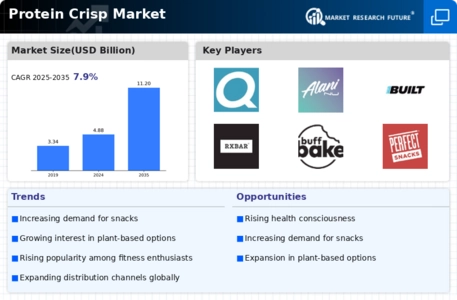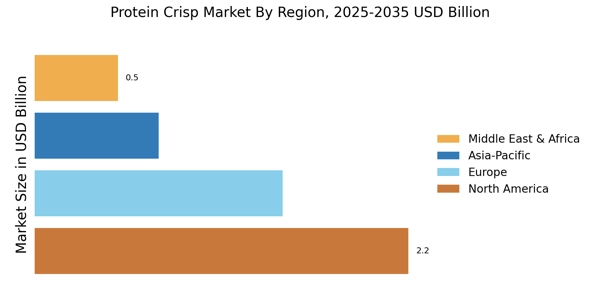Expansion of Distribution Channels
The Protein Crisp Market is benefiting from the expansion of distribution channels, particularly through e-commerce platforms. As online shopping continues to gain traction, manufacturers are increasingly leveraging digital channels to reach a wider audience. Recent statistics indicate that online sales of protein snacks have surged, with e-commerce expected to account for a significant portion of total sales in the coming years. This shift not only provides convenience for consumers but also allows brands to engage directly with their target market. Consequently, the Protein Crisp Market is likely to see enhanced visibility and accessibility, driving overall growth.
Innovations in Product Development
Innovation plays a pivotal role in the Protein Crisp Market, as companies strive to differentiate their offerings in a competitive landscape. The introduction of unique flavors, textures, and formulations is becoming increasingly common, appealing to a broader audience. For instance, the incorporation of superfoods and functional ingredients into protein crisps is gaining traction, enhancing their nutritional profile. Market data suggests that products enriched with additional vitamins and minerals are likely to attract health-conscious consumers. Furthermore, advancements in food technology are enabling manufacturers to create crisps that maintain a desirable crunch while reducing fat content. This focus on innovation not only enhances consumer appeal but also positions the Protein Crisp Market for sustained growth.
Shift Towards Clean Label Products
The Protein Crisp Market is witnessing a significant shift towards clean label products, as consumers become more discerning about ingredient transparency. There is a growing preference for snacks that contain minimal, recognizable ingredients, free from artificial additives and preservatives. This trend aligns with the broader movement towards healthier eating habits, where consumers are increasingly scrutinizing food labels. Market Research Future indicates that products marketed as 'clean label' are experiencing higher sales growth compared to conventional options. As a result, manufacturers in the Protein Crisp Market are reformulating their products to meet these consumer demands, thereby enhancing their market competitiveness and appeal.
Rising Demand for High-Protein Snacks
The Protein Crisp Market is experiencing a notable surge in demand for high-protein snacks, driven by an increasing consumer awareness of health and fitness. As individuals seek convenient and nutritious options, protein crisps are emerging as a favored choice. Recent data indicates that the protein snack segment is projected to grow at a compound annual growth rate of approximately 8% over the next five years. This trend is particularly pronounced among fitness enthusiasts and health-conscious consumers who prioritize protein intake for muscle recovery and overall well-being. The Protein Crisp Market is thus positioned to capitalize on this growing demand, as manufacturers innovate to create diverse flavors and formulations that cater to various dietary preferences.
Increased Focus on Sustainable Sourcing
Sustainability is becoming a critical consideration within the Protein Crisp Market, as consumers express a preference for products that are ethically sourced and environmentally friendly. This trend is prompting manufacturers to adopt sustainable practices in their supply chains, including sourcing ingredients from responsible suppliers. Data suggests that brands emphasizing sustainability are likely to resonate more with environmentally conscious consumers, potentially leading to increased market share. The Protein Crisp Market is thus adapting to these changing consumer values by promoting transparency in sourcing and production processes, which may enhance brand loyalty and consumer trust.


















Leave a Comment